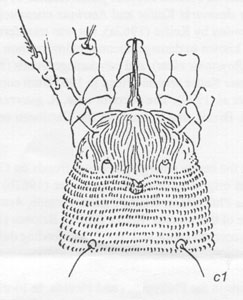common name: a coconut mite
scientific name: Acathrix trymatus (Keifer) (Arachnida: Acari: Eriophyidae)
Introduction - Distribution - Description - Survey and Detection - Damage - Selected References
Introduction (Back to Top)
Coconuts, Cocos nucifera (Arecaceae), are an important world crop. In Florida, coconut palms are used as an important part of tropical landscapes. Coconut palms are hosts to at least 12 species of Eriophyidae in nine genera worldwide.
Three species of eriophyid mites have been found on Florida coconut palms (Keifer 1962a, c; 1965). Keifer (1962a, c) described two species in 1962: Acritonotus denmarki Keifer and Amrinus coconuciferae (Keifer). Amrinus coconuciferae was originally placed in the genus Acamina by Keifer (1962a), but was transferred to Amrinus by Flechtmann (1994). Acritonotus denmarki Keifer, was described from a Florida royal palm (Roystonis elata), and can damage fronds (Keifer 1962c) of the royal and coconut palms. A third species, Aceria guerreronis Keifer was described in 1965 from coconuts in Mexico (Keifer 1965) and confirmed in Florida in 1984 (Howard et al. 1990). The coconut mite, A. guerreronis, damages floral bracts and scars developing coconuts in West Africa, Brazil, and throughout the Carribean region, including Mexico, Colombia, and Venezuela (Howard et al. 1990).
In 1996, a fourth eriophyid mite, Acathrix trymatus (Keifer), was discovered on the newly emerging coconut fronds on Grassy Key (Monroe County) by Mr. Jon G. Rackley. Acathrix trymatus was originally described by Keifer (1962b) from specimens collected in the folds of newly emerging coconut fronds in the Philippines. Keifer's generic name, Acathrix, means "short seta" for the minute scapular setae on the prodorsal sclerite of this species (Keifer 1962b). Briones (1963) investigated A. trymatus and three other eriophyid species on Philippine coconut palms and found their feeding did little damage and did not transmit cadang-cadang disease. Acathrix trymatus is a leaf vagrant and is not known to damage coconut palms or their fruit.
Distribution (Back to Top)
Acathrix trymatus is only known from coconut palms in the Philippines and Florida. In Florida, it has been found on coconut palms from the Keys (Monroe County) northward along the east coast to Jupiter (Palm Beach County). It is not known how or when this mite arrived in Florida or its distribution outside Florida and the Philippines.
Description (Back to Top)
This tiny (0.1 to 0.2 mm) wormlike mite is whitish in color. The species and genus is distinguished by the presence of a median pit just posterior to the prodorsal shield. Other distinguishing characters include prodorsal sclerite with longitudinal striations; scapular setae (sc) minute and set on prominent tubercles; c1 setae present; external vertical (ve) setae present; opisthosomal annuli narrow and subequal dorsoventrally; and the pretarsal empodium elongate with 11 to 12 rays.
Figure 1. Antero-lateral view; ve - external vertical seta; m - median pit; sc - scapular seta. Drawing by Division of Plant Industry.
Figure 2. Antero-dorsal view. Drawing by Division of Plant Industry.
Figure 3. Empodium (featherclaw). Drawing by Division of Plant Industry.
Survey and Detection (Back to Top)
This mite can be found only in folds of newly emerging coconut fronds. Sampling for this mite requires removal of a portion of the newly emerging frond and examining the folded pinnae (leaflets) with a good hand lens or a dissecting microscope. Briones (1963) reported finding A. trymatus on old as well as young foliage, but in Florida the mites have only been found on the newly emerging fronds. The best time to survey for these mites is late fall though spring because the mite is difficult to detect in the summer.
Damage (Back to Top)
Although A. trymatus can have large populations on some coconut palms, it does not appear to damage the developing coconut leaves. There is no evidence that this mite transmits any diseases to the coconut palm. However, the mites seemed to be more common on palms showing the symptoms of lethal yellowing disease. Two species of predatory mites were found with A. trymatus in Monroe County: one was a cheyletid, Cheletominus duosetosus Muma (Cheyletidae) and the other was a phytoseid, Neoseiulus sp. (Phytoseiidae).
Selected References (Back to Top)
- Briones ML. 1963. Habitat, gross morphology and geographical distribution of four new species of eriophyid mites from coconut in the Philippines. FAO Plant Protection Bulletin 11: 25-30.
- Flechtmann CHW. 1994. Amrineus cocofolius N.G., N.SP. (Acari: Eriophyidae) from Brazil. International Journal of Acarology 20: 57-59.
- Howard FW, Abreu-Rodriguez E, Denmark HA. 1990. Geographical and seasonal distribution of the coconut mite, Aceria guerreronis (Acari: Eriophyidae), in Puerto Rico and Florida, USA. Journal of the Agricultural University of Puerto Rico 74: 237-251.
- Keifer HH. 1962a. Eriophyid studies B-6. Bureau of Entomology, California Department of Agriculture, Sacramento. 20 p.
- Keifer HH. 1962b. Eriophyid studies B-7. Bureau of Entomology, California Department of Agriculture, Sacramento. 20 p.
- Keifer HH. 1962c. Eriophyid studies B-8. Bureau of Entomology, California Department of Agriculture, Sacramento. 20 p.
- Keifer HH. 1965. Eriophyid studies B-14. Bureau of Entomology, California Department of Agriculture, Sacramento. 20 p.


